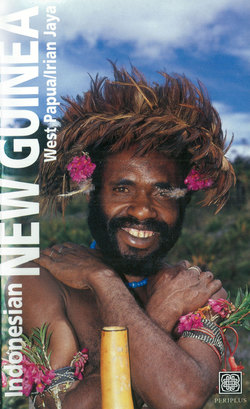Читать книгу Indonesian New Guinea Adventure Guide - David Pickell - Страница 9
ОглавлениеGEOGRAPHY
A Vast and Rugged Island
The island of New Guinea is enormous, spanning 2,400 kilometers end to end, and 740 kilometers at the shoulder. Covering 792,540 square kilometers, it is the world's second-largest island, behind Greenland, and just ahead of Borneo.
The island is neatly bisected at longitude 141°E, with the western half being the Indonesian province of West Papua, and the eastern half being part of Papua New Guinea, an independent country. West Papua's 421,981 square kilometers constitute a whopping 22 percent of Indonesia's total land area.
The shape of New Guinea has been likened to that of the cassowary bird, and the westernmost peninsula, nearly cut off from the "body" by Bintuni Bay, is called the Bird's Head—"Kepala Burung" in Indonesian, and "Vogelkop" in Dutch.
A 2,000-kilometer-long cordillera of craggy mountains running the length of the island is New Guinea's most distinctive topological feature. The crests of the main divide top 3,000 meters in many places, and a handful of rocky peaks soar above 4,500 meters. Small permanent snowfields and relict glaciers still grace the highest elevations.
Towering cordillera
West Papua's mountains are geologically quite recent, consisting largely of sedimentary limestones, sandstones and shale that has been uplifted and faulted on a massive scale by plate movements. The central cordillera traces the exact line where the Sahul Shelf and the Pacific Ocean Plate meet.
Volcanic rock is not common in the mountains, but in one of the few places an igneous intrusion has appeared—in the Sudirman Range—the outcrop has proved to be incredibly rich in copper, gold and silver. (See "Tembagapura" page 51.)
The central mountain chain comprises three contiguous ranges: the Wisnumurti Range, running westward from the Papua New Guinea border; the Jayawijaya Range, defining the southern reach of the Baliem Valley; and the Sudirman Range, extending west to the Paniai Lakes.
[Note: The Dutch names for these ranges, beginning from the border, were: Star Mountains, Oranje Mountains and Nassau Mountains, sometimes all simply called the Snow Mountains. At least one contemporary source has incorporated the Wisnumurti Range into the Jayawijaya Range.]
Despite the tropical latitude, permanent snowfields cap the Sudirman Range near Puncak Jaya.
The Wisnumurtis are topped by Gunung Mandala (formerly Mt. Juliana) at 4,700 meters and Puncak Yamin at 4,595 meters. Gunung Trikora (formerly Mt. Wilhelmina) crowns the Jayawijaya Range just southwest of the Baliem Valley, reaching 4,743 meters.
West Papua's highest peak is the pride of the Sudirman Range: Puncak Jayakesuma (formerly Carstensz Top), or simply Puncak Jaya. Reaching 4,884 meters (although it is often marked, incorrectly, 5,029 meters on maps), this is the highest point between the Himalayas and the Andes. Several other peaks in the area top 4,000 meters, including Ngga Pulu (4,860 meters).
The silty mouth of the Timika River; emptying into the Arafura Sea.
Coastal swamps
The south-facing slopes of the mountain chain fall off sharply, yielding to dense forest and then coastal swamps. In the west—near the island's "neck"—these slopes are steep ridges of sedimentary rock, scarred by landslides and cut by short, powerful rivers which spill from great gorges just a few kilometers from the coast.
East of Puncak Jaya, the southern coastal forest broadens, and the swamplands around the Casuarina Coast are vast, reaching 300 kilometers inland. Several rivers here are navigable almost to the mountains, and the land is so flat that tides affect river height far inland.
At the far southeastern corner of West Papua, near Merauke, there is a large, anomalous stretch of dry, grassy savannah. This environment, which seems to belong more to Australia or Africa than New Guinea, supports great numbers of deer and wallabies.
The Lake Plains region
The northern slopes of the mountains descend gradually, yielding to foothills and then the vast Mamberamo basin. This is the Lake Plains region, or Meervlakte. It is flat and swampy, full of nipa palms and lowland forest, and little explored.
The Mamberamo and its two main tributaries—the Taritatu (formerly Idenburg) flowing from the east, and the Tariku (formerly Rouffaer) from the west—are slow, silty meandering rivers. Thousands of oxbow lakes, and other shallow, sometimes seasonal lakes dot the region.
West Papua's lowland swamps in places reach 300 kilometers inland.
The Bird's Head
Bintuni Bay cuts deep into West Papua, and its inner reaches form one of the most extensive mangrove swamps in the world. North of Bintuni is the Bird's Head, which is made up of lowland forest to the south, and more mountainous regions to the north, marked by the Tamrau Mountains, and the Arfak Mountains near Manokwari.
Parts of the Bird's Head exhibit karst formations, the tropical climate having weathered the limestones to fantastically shaped spires and gorges.
The island fringe
Yos Sudarso Island (also called Kimaam) is very large—170 by 100 kilometers—but low, swampy and separated from the mainland only by a narrow channel. Off the Bird's Head are the Raja Empat islands: Waigeo, the largest; Batanta and Salawati, near Sorong; and Misool, which takes its name from a medicinal bark prized by the Javanese. Cenderawasih—"Bird of paradise"—Bay (formerly Geelvink), is the site of numerous small islands, and to its north are the large islands of Biak, Supiori, Numfor and Yapen.
The Geological History of New Guinea
Figure 1. Jurassic Period (170-140 million years ago)
Figure 2. Cretaceous Period (140-63 million years ago)
Figure 3. Eocene Epoch (53-37 million years ago)
Figure 4. Oligocene Epoch (37-24 million years ago)
Figure 5. Middle Miocene Epoch (15 million years ago)
Figure 6. Pliocene Epoch (5-2 million years ago)
After Timothy Flannery, The Mammals of New Guinea (1990)
